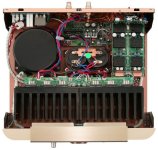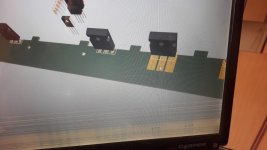hahah... you you still don't have a problem with his calculation???post #14, this is a low power supply for the front ends, and so i have no problems with his calculations. seems typical..
why? i ignore his calculations and not make it my problem...
if you can not understand the design to begin with, then everything is off the table, I will never whack my head about it...
if you can not understand the design to begin with, then everything is off the table, I will never whack my head about it...
post #14, this is a low power supply for the front ends, and so i have no problems with his calculations. seems typical..
i suspect that the front end of the amp this psu supplied is class A so that loading is pretty much constant...
best way is to get to look at the actual unit, if i were doing it, based on the schematics, i will know what to do..
It seems that you know what to do... I suggest looking at the actual schematics in question first.... that might be the starting point?
Did you miss my post where I clearly stated that you overlooked the fact... that the choke in question supplies the full current grunt needed by the amplifier PCBs? I even posted a little photo...
no, i saw what you posted, but i have a different idea, i have seen so many different Japanese design's from repairing Japanese amps in the 80's that are similar to this Marantz, so it will be useless to argue with you about what you are talking about...sorry, i will not slug it out with you, waste of time...
Fellas,
Have a better look... the choke supplies current to the main amplifier section. This is why my calculations pointed to a 12A rating... the worst-case power consumption/output, 4-ohm load.
The inductance could be calculated only if the amp is examined under load on a test bench.
I think I've provided enough info here, for something that should not really be encouraged... ripoff of the original design.
View attachment 1153453
Do you mean choke supplies current for amplifier output?
Based on what? Your experience?? Did yous see the size of that choke?? Drawing from your experience, do you think Marantz would use it just for the pre-amp section??no, i saw what you posted, but i have a different idea,
Woah... Impressive! Did you bother to look at their schematics?i have seen so many different Japanese design's from repairing Japanese amps in the 80's that are similar to this Marantz
Of course, it would be useless... you did not bother to check the circuit diagram, went on showing here how you are experienced and know so much, and then admitted the choke calculations are correct... for a pre-amp section - which is WRONG., so it will be useless to argue with you about what you are talking about...sorry, i will not slug it out with you, waste of time...
Yes Yes Yesno, no, no.....
Still refusing to follow the red arrow??
ok, i will have to report this thread as encouraging piracy of IP....
Haha... but YOU contributed as well in a thread.... ah the lengths you're prepared to go to... just to avoid acknowledging that you were wrong, like - completely. And your experience did not help... like a single bit.
you got that right, Marantz is right....
i was wrong about you....i thought you know...look at post #32 was trying to say that from my posts...Haha... but YOU contributed as well in a thread.... ah the lengths you're prepared to go to... just to avoid acknowledging that you were wrong, like - completely. And your experience did not help... like a single bit.
i am out of here....
the choke is most likely steel cored, EI most likely, i designed such chokes, just because the can is round does not mean it is a toroid...
Looks like R803,R804 are 1R, 1/2W. That puts some limit on what the current through the choke is likely to be. BTW, have a pair of those power amps here. Haven't gotten around to opening them up to look inside yet, though. SQ is very good. Better in some ways than Benchmark AHB2.We only know the inductance (2x180mH ) but do not know the wire gauge and toroidal core.Any ideas?
- Home
- Amplifiers
- Power Supplies
- Marantz MA9S2 choke input power supply

